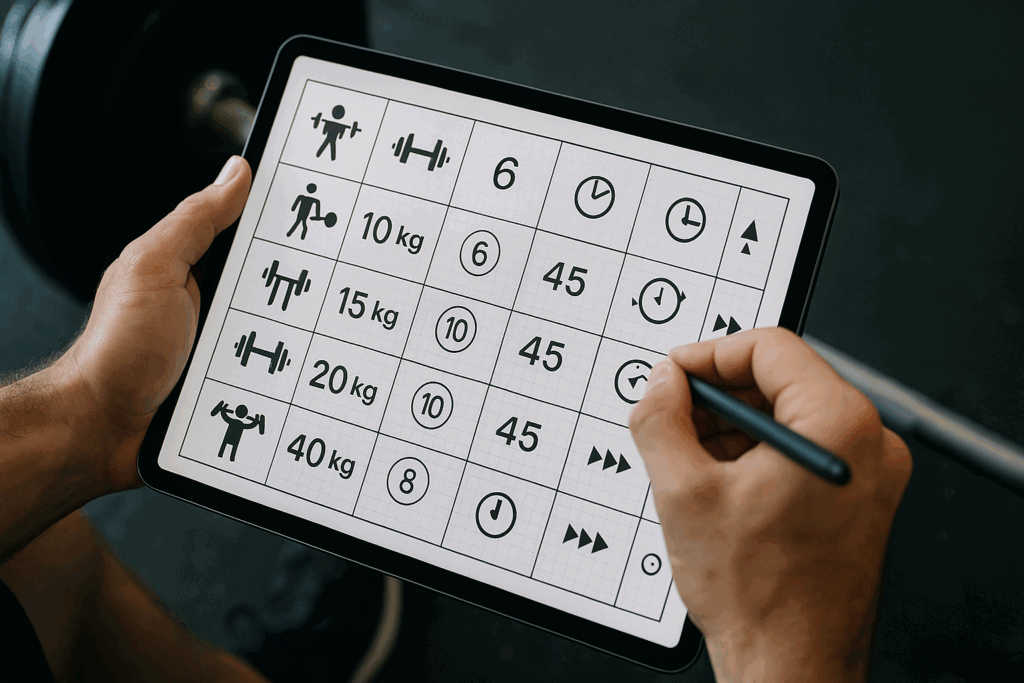Introduction: Why a Weight Lifting Chart Is Critical for Serious Muscle Gains
In the pursuit of muscle growth and strength, one essential yet often overlooked tool is the weight lifting chart. This simple yet powerful tracking method acts as a blueprint for consistent progress by mapping out weights lifted, reps performed, rest intervals, and overall training volume. More than a record-keeping tool, a weight lifting chart provides structure and accountability, offering a data-driven roadmap to effective hypertrophy. For athletes, fitness professionals, and serious trainees alike, integrating a chart into a structured routine can make the difference between stalled progress and continual advancement. As training becomes more strategic, the weight lifting chart evolves into a vital component for sustainable success.
You may also like: The Ultimate Hypertrophy Workout Program for Building Strength and Size

Understanding the Science Behind Strength and Hypertrophy
At the heart of muscle development are several physiological mechanisms, including mechanical tension, metabolic stress, and muscular damage. These triggers activate protein synthesis, leading to the growth of muscle fibers. However, these effects are highly dependent on the consistency and intensity of training over time. Without proper monitoring, it’s difficult to know whether you’re applying enough stimulus to provoke adaptation. This is where the weight lifting chart becomes invaluable. It allows you to track not only your strength increases but also the frequency and quality of your training stimulus. From identifying effective rep ranges to adjusting rest periods, the chart enables a tailored approach based on real data rather than guesswork.
How a Proven Weight Lifting Chart Enhances Program Design
Program design in strength training is as much art as science. While principles like progressive overload and specificity are universal, their implementation should be personalized. A proven weight lifting chart allows you to individualize your training plan by providing feedback on what’s working and what isn’t. If bench press strength stalls for three weeks, the chart can help you identify whether you’re overreaching, under-recovering, or failing to increase training volume. With this insight, you can strategically rotate exercises, adjust intensity, or integrate deload weeks. The chart becomes your analytical companion—helping optimize your split, fine-tune your lifts, and guide weekly programming adjustments for continuous gains.

Essential Components of a High-Impact Weight Training Chart
An effective weight training chart includes more than just exercise names and weights lifted. It should encompass key metrics such as sets, reps, rest periods, Rate of Perceived Exertion (RPE), and even tempo. Including notes about form cues or perceived fatigue adds qualitative data to the quantitative. Some advanced charts also calculate training volume (sets × reps × load), which helps estimate overall workload. Tracking these details allows you to balance training intensity and recovery needs, and it highlights the importance of load management to avoid injury. Whether you use pen and paper or digital apps, the completeness of your weight training chart directly affects its usefulness and accuracy.

Monitoring Long-Term Gains with Your Weight Lifting Chart
One of the most powerful aspects of a weight lifting chart is its ability to track progress over time. Patterns become apparent when weeks of training data are compiled into one place. You might notice that your squat improves consistently when you follow a 5×5 protocol but stalls with higher reps. Alternatively, you may find that strength gains coincide with specific nutritional phases or recovery strategies. Such insights help you design better future programs and avoid repeating ineffective patterns. The chart thus functions not only as a historical record but as a guidepost for building personalized, evolving training strategies based on real-world outcomes.

Weight Training Chart Strategies for Breaking Through Plateaus
Even the most well-designed training program can hit a plateau. That’s where your weight training chart becomes a diagnostic tool. By analyzing volume, intensity, and frequency data, you can pinpoint where your program may be faltering. Perhaps your weekly training volume has dropped due to skipped sets, or you’re no longer applying sufficient load increases. By identifying these issues early, you can implement strategic changes—such as rest-pause sets, tempo variations, or periodization adjustments—to reignite progress. In this way, the weight training chart serves not just as a tracker but as a proactive instrument for continued growth.
Accountability and Motivation Through Structured Tracking
Training consistency is critical for muscle growth, and few tools offer more psychological reinforcement than a well-maintained weight lifting chart. Logging each workout instills a sense of discipline and helps maintain focus on long-term goals. Reviewing past successes—such as new personal records or increases in training volume—can boost motivation during difficult phases. Even minor improvements become visible wins that fuel momentum. The weight lifting chart reinforces the habit of intentional training and helps transform sporadic effort into structured progression, making it easier to stay on track and avoid burnout.
Designing Effective Split Routines with a Weight Lifting Chart
Split routines allow you to target specific muscle groups on different training days, maximizing workload and recovery. A weight lifting chart is instrumental in structuring and analyzing the effectiveness of these routines. For instance, if your chest day shows high volume but shoulder strength isn’t improving, your chart may reveal imbalances that require adjustment. You can evaluate whether your training split distributes effort evenly and supports balanced growth. Whether you’re following an upper/lower, push/pull/legs, or full-body split, the chart ensures that no muscle group is neglected and that recovery periods are well-placed for optimal adaptation.

Using Periodization Within Your Weight Training Chart
Periodization is the planned manipulation of training variables to enhance performance while minimizing fatigue and overtraining. A weight training chart makes it easy to apply linear, block, or undulating periodization methods. You can clearly track how load, volume, and intensity change over weeks or months and assess how your body responds. For example, you might gradually increase intensity over four weeks and then schedule a deload week, all of which can be visualized within your chart. Such structured programming helps reduce performance plateaus and supports long-term hypertrophy and strength development.
Customizing Your Chart to Fit Specific Training Goals
Your weight lifting chart should reflect your current goal—whether it’s building muscle, increasing strength, or cutting fat. For hypertrophy, you’ll focus on high-volume sets with moderate intensity. Your chart will track weekly set totals per muscle group to ensure adequate stimulus. For strength, low-rep high-load training takes center stage, and your chart will monitor changes in max lifts and RPE. For fat loss, the chart can be used to maintain strength while adjusting training volume to accommodate reduced caloric intake. Customization ensures your chart serves as a strategic ally, no matter the phase of your training journey.
Enhancing Training Results by Tracking Nutrition and Recovery
Though often overlooked, tracking nutritional habits and recovery status within your weight lifting chart adds critical context to your lifting performance. A decrease in strength might not stem from poor training but from insufficient protein intake or sleep deprivation. Logging meals, hydration, supplements, and sleep alongside training sessions can illuminate hidden factors affecting your progress. Over time, this integrated approach provides a complete picture of what fuels—or hinders—muscle growth, allowing you to make holistic, evidence-based adjustments for sustained improvement.
Common Mistakes and How to Avoid Them in Chart Use
Using a weight lifting chart effectively requires attention to detail and consistency. One common mistake is failing to log data accurately or skipping entries altogether. Incomplete information leads to poor insights and missed trends. Another pitfall is focusing solely on numbers while ignoring qualitative feedback, such as soreness or fatigue. To get the most out of your chart, always record rest intervals, effort levels, and even mood. This comprehensive data collection will inform smarter programming decisions and enhance your training outcomes by turning your chart into a fully functional feedback system.
Tools and Templates to Build Your Own Weight Lifting Chart
You don’t need complex software to build an effective chart. A simple spreadsheet with columns for date, exercise, sets, reps, weight, RPE, and rest times can serve as a powerful tool. Mobile apps like Strong, FitNotes, and Google Sheets make tracking easy and accessible. Some lifters prefer physical notebooks, which provide a tactile and rewarding experience. Regardless of the format, the goal is clarity, consistency, and completeness. By regularly updating your chart and reviewing it at set intervals, you turn data collection into a powerful tool for growth.
Frequently Asked Questions (FAQ)
How Can a Weight Lifting Chart Help Prevent Plateaus in Long-Term Training?
While many lifters rely on instinctive training, a structured weight lifting chart can be instrumental in preventing long-term performance plateaus. By systematically tracking volume, intensity, and frequency, it allows for the identification of stagnation points before they affect progress. You can modify your program more efficiently when patterns of regression or adaptation become visible. For example, if your chart shows declining progress in bench press strength over several weeks, you can proactively incorporate deloads, change rep schemes, or adjust exercise variations to stimulate new growth. Over time, this proactive approach reinforces consistent adaptation and minimizes the mental fatigue associated with repeated setbacks.
Why Should Beginners Use a Weight Training Chart for Psychological Motivation?
For beginners, strength training can feel overwhelming, especially when results aren’t immediately visible. A well-designed weight training chart not only offers a visual record of progression but also serves as a psychological reinforcement tool. Checking off milestones and seeing tangible improvement week after week creates a dopamine-driven sense of accomplishment. It fosters accountability and discipline, two qualities essential for building sustainable fitness habits. Moreover, even minor increases in weights or reps can become significant motivational wins when documented in a structured charting format.
What Are the Lesser-Known Metrics to Track in a Weight Training Chart?
Beyond sets, reps, and loads, an advanced weight training chart can include nuanced performance indicators that offer a more holistic view of progress. Tracking Rate of Perceived Exertion (RPE), sleep quality, recovery time between sets, and even mood levels on workout days can offer insights into training readiness and fatigue management. These “soft” metrics often correlate with training success more closely than just weight lifted. For instance, a trend of high RPE scores despite low weight progress could signal overtraining or nutritional deficits. Including these factors in your chart helps fine-tune programming for both physical and psychological performance optimization.
Can a Weight Lifting Chart Be Adapted for Periodization Cycles?
Yes, advanced lifters often use a weight lifting chart as a dynamic tool to plan and execute periodized training cycles. Rather than just logging workouts, the chart becomes a blueprint for phases like hypertrophy, strength, power, and deload. You can predefine intensity ranges and volume targets across 4- to 12-week mesocycles, ensuring systematic progression while reducing injury risk. Periodization-specific charts allow athletes to measure performance against the intended stimulus of each phase rather than generic improvement. This ensures not only continued gains but also long-term structural balance and muscle health.
How Do Weight Lifting Charts Improve Communication Between Athletes and Coaches?
In team or one-on-one coaching environments, a weight lifting chart acts as a shared performance log that enhances clarity and direction. Coaches can quickly identify whether an athlete is meeting expected benchmarks or whether fatigue, inconsistency, or technical issues are holding back progress. This level of transparency allows for more data-driven discussions, leading to targeted program adjustments. It also helps bridge the gap between subjective athlete feedback and objective performance metrics. When both parties have access to a detailed, real-time chart, collaboration becomes not just easier, but more precise.
Integrating Lifestyle Factors into Your Weight Training Chart for Holistic Progress
Including lifestyle markers like nutrition adherence, hydration levels, and sleep duration in your weight training chart creates a more integrated view of what influences performance. Often, people blame stalled progress on training variables alone, overlooking the impact of external stressors. By adding columns or notes for these factors, lifters can start drawing correlations—like noticing that poor sleep coincides with weaker lifts. This empowers smarter lifestyle choices and enhances recovery strategies. Holistic charting reinforces the idea that muscle growth and strength aren’t confined to the gym but are shaped 24/7 by your overall lifestyle.
Why the Right Weight Lifting Chart Format Matters for Your Learning Style
Not all charts are created equal—some individuals thrive with minimalist spreadsheets, while others benefit from colorful, visual dashboards or physical journals. Choosing the right weight lifting chart format based on your learning style can make or break your consistency. Visual learners might prefer graphs and progress bars, while analytical thinkers may want pivot tables and macros for deeper data insights. By tailoring the chart format to your cognitive preferences, you’re more likely to engage with it regularly, making it a living tool rather than a static record. This enhances adherence and maximizes the educational value of your training experience.
Using a Weight Training Chart to Identify Imbalances and Prevent Injury
A comprehensive weight training chart helps detect movement or muscle imbalances that might otherwise go unnoticed until an injury occurs. By comparing progress across different exercises and muscle groups, patterns emerge—such as consistently lagging posterior chain lifts compared to anterior-focused movements. This data can inform corrective strategies like mobility work, unilateral training, or prioritizing weak links. Longitudinal charting also allows you to track pain points or joint stress signals over time. Addressing these signs early can prevent chronic injuries and support joint health, especially for long-term lifters.
The Role of a Weight Lifting Chart in Rehabilitative and Post-Injury Training
After an injury, resuming training can be psychologically daunting and physically risky without a precise roadmap. A weight lifting chart enables you to approach post-injury training with structure and confidence. You can set conservative load thresholds, track pain-free range of motion milestones, and adjust tempo or volume systematically as recovery progresses. It also allows healthcare providers, such as physical therapists or athletic trainers, to monitor rehabilitation compliance and load progression. This structured approach supports both physical healing and mental reassurance, accelerating return-to-play timelines safely and effectively.

Future Trends in Digital Weight Lifting Chart Technology and AI Integration
Emerging fitness tech is pushing the boundaries of how we interact with weight lifting charts. Many modern training apps now integrate AI to suggest real-time adjustments based on biometric feedback like heart rate variability, sleep cycles, or bar speed. Predictive modeling may soon automate deload scheduling or offer injury risk alerts based on training trends. Some platforms even use machine learning to suggest new hypertrophy blocks tailored to your recovery curve. As data collection becomes more sophisticated, the weight lifting chart will evolve from a static record to an intelligent training partner that adapts to you in real time. This future-forward integration empowers both elite athletes and everyday lifters with more precise, personalized programming.
Conclusion: Turning Consistency into Strength with a Weight Lifting Chart
Muscle-building success is built on the foundation of progressive overload, strategic planning, and relentless consistency—all of which are magnified by the use of a proven weight lifting chart. By logging your workouts with precision and intention, you create a system that not only tracks what you’ve done but actively shapes where you’re going. From identifying strengths and weaknesses to planning periodization cycles and adapting to life’s inevitable fluctuations, the chart becomes a roadmap for sustainable performance and continual growth. In the realm of strength and muscle, there are no shortcuts—but with the clarity and guidance of a well-kept weight training chart, there is a clear, reliable path forward. Let your data tell your story, and let your chart guide your gains.
Further Reading:
Workout Charts Exercises – 10 Free PDF Printables | Printablee





